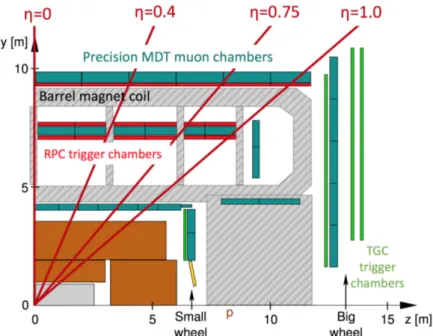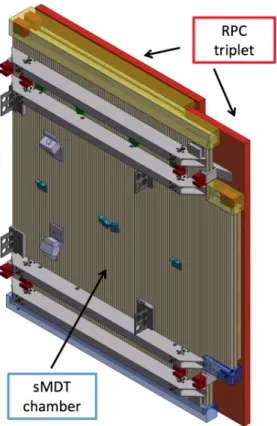PoS(LHCP2018)083
Spectrometer with Integrated Small Diameter Drift Tube Chambers and Thin-Gap Resistive Plate
Chambers
Verena Walbrecht ∗
on behalf of the ATLAS Muon Collaboration
Max Planck Institute for Physics, Munich (Germany) E-mail: walbrech@mpp.mpg.de
The ATLAS muon spectrometer comprises excellent muon trigger capabilities and high muon momentum resolution up to the TeV scale. Yet, in a small region between the barrel and end- cap parts of the muon spectrometer, a non-negligible muon trigger rate from charged particles not emerging from the pp interaction point has been observed. To prevent such fake triggers, the end of the inner ring of the muon spectrometer barrel in the barrel end-cap transition region, which is currently not equipped with trigger chambers, will be instrumented with resistive plate chambers (RPCs) in the next long shutdown of the LHC in 2019 and 2020. As the space in this region is extremely limited the present muon drift-tube chambers will have to be removed and replaced by an integrated system of thin-gap RPCs and small diameter muon drift-tube (sMDT) chambers. Final prototypes of both chambers have been successfully produced recently fulfilling all very tight spatial requirements and showing the expected performance. Results of mechanical measurements of the sMDT chamber geometry with a coordinate measurement machine show a wire positioning accuracy of better than 10 µm. The tests of the thin-gap RPC in a high-energy muon beam at CERN show full chamber efficiency and an unprecedented time resolution better than 0.5 ns. In the conference contribution the design, construction, and tests of the new sMDT and RPC chambers, as well as the progress of series production, will be presented.
Sixth Annual Conference on Large Hadron Collider Physics (LHCP2018) 4-9 June 2018
Bologna, Italy
∗


